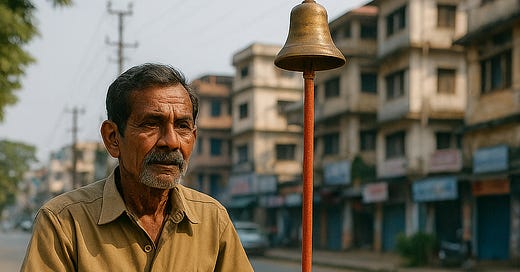Not your usual summer fling
Kulfi hits a sweet spot in the eastern and north-eastern parts of India
Happy Sunday, everybody!
I hope you’re doing fabulous because I sure am (apart from the fact that peak adulting is happening, but that’s a rant for another time).
As always, I am back with some Desi Scoop :
<quite literally>
I have been spotting manually operated kulfi thelas with BELLS (and not horns) in Guwahati!
In today’s EV era, this manually operated Kulfi thela with a bell is definitely giving OG vintage summer vibes in India .
(For all you ‘Desi Aesthetic’ enthusiasts- add kulfi to your lookbooks right away!)
On top of that, Gen Z is tweeting about nolen gur kulfi and calling it a “core memory”?!
What’s important is- why does Kulfi need a comeback when it has always been a classic?
To know the whole fall-and-rise story, we need to look back and understand what went wrong.
TL;DR:
Kulfi didn’t just come back ; it completed a cultural loop.
From imperial legacy → market erasure → regional reinvention.
Textbook Kulturkreis behavior!
Let’s begin, shall we?
Act 1: Fall of the Frozen Icon
Much like Govinda’s neon wardrobe, kulfi fell hard in the early 2000s. And the reasons were painfully modern:
Industrial ice cream happened.
With brands like Amul and Kwality Walls rolling out machine-made marvels in shiny packaging, kulfi couldn’t keep up.
I mean,
Why wait for bhaiyya to pull a kulfi out of a tin mold when you could get a triple-choco-chip explosion with sprinkles?McDonaldization of food
Efficiency, predictability, and standardization replaced traditional methods.Kulfi, being artisanal and requiring slow cooking, could not compete with factory-made ice creams that had longer shelf lives and aggressive marketing.
Class anxiety kicked in
Post the LPG reforms of 1990, India was going through a Western fetish.
Upward mobility soon became synonymous with using more and more westernized products (and ideals).
Ice cream became aspirational- all those ads with rich kids in white shirts eating "butterscotch fantasy" made kulfi feel too local, too “unhygienic,” too... real to even exist.Street vendors struggled.
No cold storage, very low shelf life, hardly any shelf space- that was kulfi back then.
Hence, the vendors resorted to selling ice-cream for their survival.
At this point, kulfi wasn’t just melting.. she was disappearing!
Act 2: Revival (and reform)
Akin to Chikankari, Kulfi, too, has made a kickass comeback.
It’s like the clean girl of desserts- very demure, very mindfully consumed and grandma-approved.
In fact, now Eastern and North-Eastern India make for 12% of the domestic Kulfi market. Here’s why-
Glocalisation
They say that food is a marker of cultural identity.
Wow!Kulfi understood its assignment well! They capitalized on this theory by launching nolen gur kulfi in Kolkata-making it an instant hit.Kulfi is now a recontextualized marker of the evolving regional culture circle in Eastern and Northeastern India.
Nostalgia
Psychologically, when we feel uncertain, we seek comfort.
In food, that often means returning to childhood tastes.
A 2023 Culinary Heritage poll showed 72% of East Indians prefer traditional sweets over "frozen desserts" made with palm oil and food colour.
Eastern Indian dessert-lovers are now choosing kulfi for its clean, real ingredients. No stabilizers, no cringe names.
Just milk, saffron, and pure vintage vibes.Branding, but make it Desi
From Wow! Kulfi to Kulfi Nation, this isn’t your uncle’s kulfi anymore.
It’s soft-launched, mood-boarded, and comes with pastel packaging.
Suddenly, kulfi isn’t just a frozen dessert — it’s a heritage product with Instagram appeal.
Cultural sociology 101: reinvention via aesthetic capital.Tech meets tradition
From cart to cloud — food delivery apps and hyperlocal delivery are taking homemade kulfi straight to your screen (and belly).Mindful consumption
It’s the post COVID era- people prefer small-batch production and maximum customization.
Hence, there is a surge in handmade, crafted and artisanal products, and this market is only getting bigger. Indu Icecream (Mumbai) is one such example.Act 3: The Final Glow-up
Certainly, you people must be totally raving over the low-calorie, protein-rich Kulfi.
And if not, well then, I come bearing good news.You see, India is going through a phase of food glow-ups- the proteinification wave.
The latest product to undergo this beautification is Kulfi.
Of course, I mean, there should be something to save the market from the BFY(betterforyou) dessert fatigue!
It’s as though Kulfi has risen from the dark all of a sudden!
But wasn’t it originally a shahi dessert symbolizing luxury and indulgence?
In fact, now that I think about it, even chikankari re-emerged after being branded and endorsed by celebrities.
It’s all part of Desi capitalism, don’t you think?
Anyway, what matters is that the desert market in India has finally regained its senses, and I am all for it.
Also, if you’re wondering if the reappearance of kulfi is a revival or a reform, don’t bother, because it’s both in this case.
In case you have a different opinion, feel free to comment/reply to this post- I’d love to know your POV.
Until next time.
Toodeloo!






